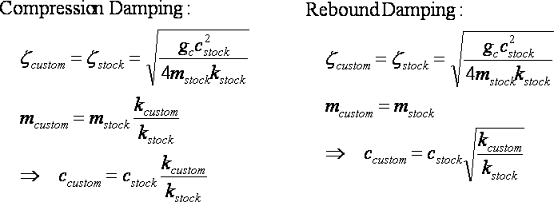

Tuning Basics
Sample Applications

ReStackor Sample Applications
Finally computer software to tune a shim stack
Damping Correction Needed for a Spring Rate Change
Spring-mass-damper suspension theory defines two parameters that describe the relationship of mass, spring rate and damping on the oscillation characteristics of a suspension:
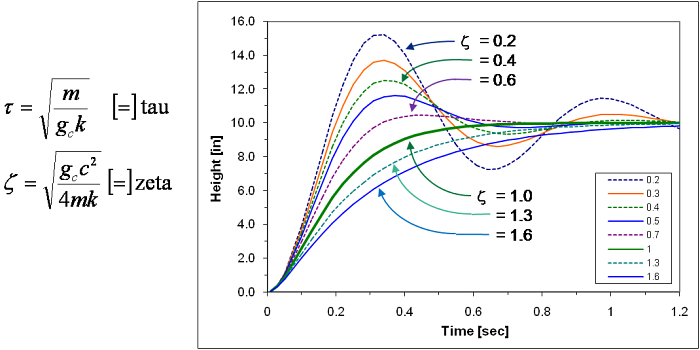
Spring-mass-damper suspension theory defines two parameters that completely describe the response and oscillation characteristics of a suspension.
The suspension oscillation frequency is defined by tau. A stiff springs or a light vehicle increase the value of tau and the oscillation frequency of the suspension. Defining tau as the ratio of mass to spring rate makes tau essentially equivalent to race sag.
The second parameter zeta defines the relationship of weight (m), spring constant (k) and the shock absorber damping coefficient (c) on the oscillation characteristics of the system.
If two bikes with different weights and different spring rates are setup so that the value of tau and zeta match the suspensions and “baby buggy” oscillations of the two suspensions will be exactly the same and each suspension will retrace the zeta response curve in the figure above when hit with the same blow.
Resetting damping rates to match a spring rate change
Application of the fundamental relationships of spring-mass-damper theory define the change in shock absorber damping needed to adjust for a change in spring rate. That relationship, including the effect of weight and spring rate, is:
Many riders assume they can correct the shock absorber damping by simply running the clickers a couple of clicks in or a change in the oil viscosity. This is not the case as demonstrated in the frames below.
![]()
Damping Requirements for a Spring Rate Change
The case below demonstrates the change in fork compression damping needed for a 20% change in spring rate. The first step is to compute the damping force provided by the stock shock absorber shim stack.

ReStackor pro provides the tools you need to determine the damping rates of the stock suspension and scale those damping rates to accommodate changes in spring rate.
The damping coefficient is defined as the damping force produced by the shock divided by the suspension velocity. Re-plotting the above ReStackor pro results in terms of damping coefficient gives a nice linear damping curve for the stock shim stack configuration:

The damping coefficient curve computed by ReStackor pro highlights features of the damping profile and easily discriminates between linear, progressive and digressive damping profiles.
For a 20% change in spring rate we need a 20% increase in the damping coefficient. That target damping level needed for a 20% increase in spring rate is shown by the dashed red line in the figure above. The frames below investigate achieving that damping by clicker adjustments, oil viscosity changes and changes to the shim stack.
![]()
Clicker adjustments are inadequate to correct damping rates for a spring rate change
Trying to increase the shock absorber damping using the clickers results in a digressive damping curve. The linear damping profile for the stock suspension cannot be matched through adjustment of the clicker settings.
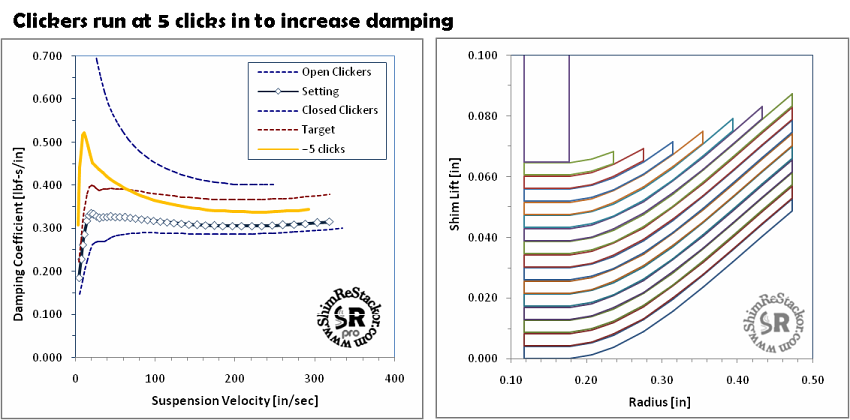
Clicker setting adjustments cannot correct damping for spring rate changes and produce the linear damping curve of the stock suspension.
Trying to correct damping using the clickers produces the following problems:
-
Running the clickers 5 clicks in to produce the needed damping increase results in a low speed damping spike. The damping spike produces a harsh non-compliant ride at low speeds. The harsh ride is further amplified by the increased spring rate.
-
At high speed the digressive damping curve produced by the clicker adjustment results in reduced damping forces and a suspension that will blow through its stroke on large hits. The digressive damping curve partially defeats the spring rate increase.
Attempting to use the clickers to adjust for a spring rate change results in a damping profile that is harsh at low speed, further amplified by the increased spring rate, and too soft at high speed, defeating the effect of the spring rate change.
Attempting to use the clickers to adjust for a decrease in spring rate also produces a mismatch in damping but in the opposite direction. Running the clickers further out results a digressive damping curve. Low speed damping rates will be too small resulting in a suspension with a tendency to tuck on corner entrances. That tendency will be further amplified by the reduced spring rate. As suspension speeds increase the damping will increase resulting in a suspension that is too stiff to take full advantage of the suspension travel defeating the central purpose of the spring rate change.
![]()
Changes in Oil Viscosity cannot be used to Compensate for a Spring Rate Change
Oil viscosity effects the low speed damping characteristics of the suspension but does little to effect the high speed damping forces. Increasing the oil viscosity from 5 wt to 10 wt gives the correct low speed damping but does not provide the high speed damping rates needed for the spring rate change.
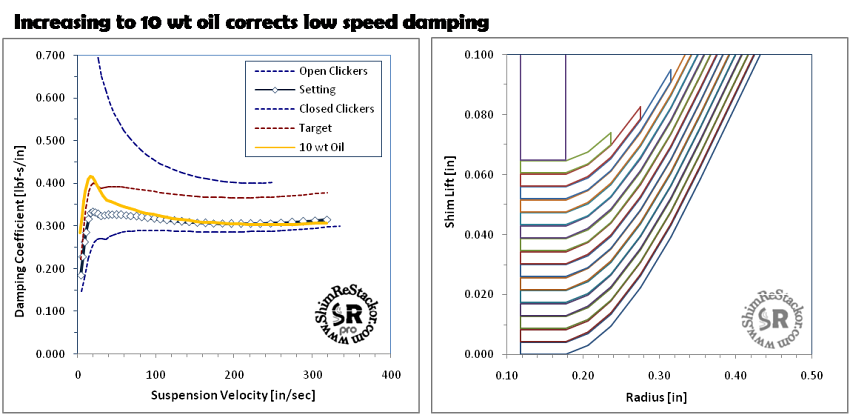
Shock absorber oil viscosity changes cannot provide the necessary high speed damping rates required for changes in the suspension spring rate.
Trying to correct for the spring rate change oil viscosity produces the following problems:
-
Increasing the oil viscosity from 5 wt to 10 wt gives the correct low speed damping rates but the damping falls off above suspension velocities of 30 inches/sec
-
Above suspension velocities of 50 inches/sec there is no increase in damping. This will allow the suspension to blow through its stroke on large hits partially defeating the spring rate increase
Attempting to correct shock absorber damping rates by changing the shock absorber fluid viscosity results in a digressive damping curve that is too stiff at low speed and too soft at high speed. This produces a harsh ride at low suspension speeds due to the low speed damping spike and a suspension that will blow through its stroke on large hits due to the inadequate high speed damping. Adjusting damping rates to compensate for a spring rate change requires the shock absorber shim stack to be modified.
![]()
Tuning the Shim Stack for a Spring Rate Change
Correcting damping forces for a change in spring rate requires the shim stack to be modified to produce the desired damping profile. In this case changing the first two shims from a thickness of 0.1mm to 0.15 mm provides the desired damping profile.
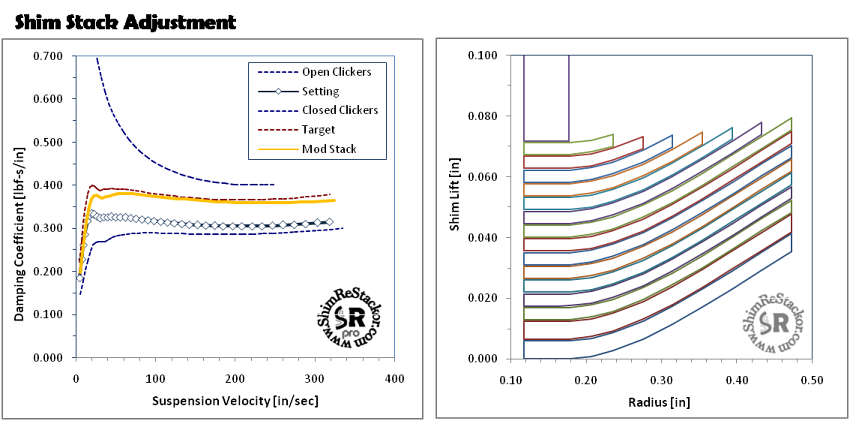
Modifying the shim stack provides the required damping rate changes while preserving the linear damping profile of the stock suspension.
Adjusting the shim stack preserves the linear damping profile of the stock shock configuration and duplicates the damping performance, ride and feel of the stock suspension. From this linear damping profile the rider can run the clickers a couple of clicks in to produce a digressive damping profile or a couple of clicks out to produce a progressive profile. This gives the rider the capability to adjust for local riding conditions without permanently being stuck in a progressive or digressive damping curve.

